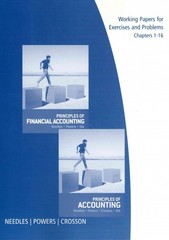Question
Porl Corp. makes an unassembled chair that sells for $50. Product costs are $20 per chair. The product line manager suggests that Porl Corp. should
Porl Corp. makes an unassembled chair that sells for $50. Product costs are $20 per chair. The product line manager suggests that Porl Corp. should instead sell an assembled chair, as revenues will be higher. Specifically, the market price for this chair is $60. The cost of assembly is $11. Which of the following statements is true?
1 point
The company should not sell the assembled chair because the $11 in costs per table is more than half of the cost of production.
The company should sell the assembled chair because the total contribution margin increases.
The company should sell the assembled chair because revenues per table are $10 higher.
The company should not sell the assembled chair because the $10 in incremental revenue is less than the $11 in incremental costs.
2.
Question 2
Teddy, Inc. sells donuts. They pride themselves on fresh ingredients and products, and therefore bake the donuts fresh each morning.The average selling price is $1 per donut. Average variable costs are $.40 per donut. When producing at full capacity - 1,000 donuts per day - the fixed cost is $.10 per donut.
Just before closing, a tour bus arrives and the driver offers to purchase 100 donuts that are already made for $40. As he is just about to lock up, Teddy's manager accepts the offer.
Considering a financial perspective, which of the following is true?
1 point
Teddy's manager is incorrect, as the special offer price is below per unit costs.
Teddy's manager is correct, but this is the lowest price he could accept.
Teddy's manager is incorrect, as the special offer price is below normal revenues.
Teddy's manager is correct, and he probably would have accepted a lower price.
3.
Question 3
Boris Company has multiple business units. Unit B has the following information: sales revenue is $300,000; variable expenses are $200,000; fixed expenses are $150,000. Fixed expenses - which are mostly represented by traceable (and avoidable) business unit costs (e.g., rent, depreciation, etc.) - are calculated for each business unit separately.
What is the effect on Boris Company as a whole if Unit B is eliminated?
1 point
Total profit will increase by $50,000.
Total profit will decrease by $50,000.
Total profit will decrease by $300,000.
Total profit will not change.
4.
Question 4
Lillian Corporation currently makes a key input into its main product. Bernard, a manager within Lillian, is arguing that the organization should outsource production of this input, and buy it from a third-party supplier.
Currently, the per-unit manufacturing costs are $18 in materials, $20 in labor, $12 in variable manufacturing overhead, and $8 in fixed costs per unit. The fixed costs are allocated from the total of fixed costs generated by the entire factory.
Bernard's third-party supplier would charge Lillian $60 per unit, and could sell to Lillian the entire 1,000 units Lillian needs each year.
Also, if Bernard's plan is implemented, it can use the capacity currently being used to produce an input to generate additional profit of $11,000.
Assuming Lillian is adopting a financial perspective, which of the following is true?
1 point
Lillian should follow Bernard's plan, because doing so will increase profits by $9,000.
Lillian should not follow Bernard's plan, because doing so will decrease profits by $10,000.
Lillian should not follow Bernard's plan, because doing so will decrease profits by $2,000.
Lillian should follow Bernard's plan, because doing so will increase profits by $1,000.
5.
Question 5
Opal Company has multiple business units. Unit 1 has the following information:
Sales revenue: $200,000
Variable expenses: 140,000
Fixed expenses: 100,000
Fixed expenses, which are mostly represented by shared capacity costs (e.g., rent, depreciation, etc. for the factory as a whole), are allocated evenly to business units.
Harry, a manager within Opal Company, is wondering whether Opal should drop Unit 1.
Which of the following statements are true? (Check all that apply.)
1 point
The $140,000 in variable expenses is relevant.
The $200,000 in sales revenue is relevant.
If the fixed expenses are unavoidable, they are relevant.
If the fixed expenses are avoidable, they are relevant.
Step by Step Solution
There are 3 Steps involved in it
Step: 1

Get Instant Access to Expert-Tailored Solutions
See step-by-step solutions with expert insights and AI powered tools for academic success
Step: 2

Step: 3

Ace Your Homework with AI
Get the answers you need in no time with our AI-driven, step-by-step assistance
Get Started


